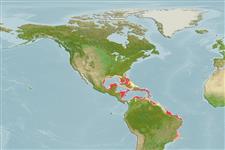Environment: milieu / climate zone / depth range / distribution range
पारिस्थितिकी
समुद्री प्रवाल-भित्ति संयुक्त; गहराई सीमा 10 - 70 m (Ref. 9710), usually ? - 30 m (Ref. 9710). Tropical; 32°N -
Western Atlantic: Bermuda and southern Florida, USA to northern South America.
आकार / वज़न / Age
Maturity: Lm ? range ? - ? cm
Max length : 9.0 cm TL पुल्लिंग / अलिंग; (Ref. 26340)
पृष्ठीय रीढ़ (सम्पूर्ण) : 10; पृष्ठीय सौफट रेज़ (सम्पूर्ण) : 10 - 12.
Inhabits rocky and reef areas. Occurs in pairs (Ref. 9710). Synchronously hermaphroditic.
Life cycle and mating behavior
Maturities | पुनरुत्पत्ति | Spawnings | Egg(s) | Fecundities | लार्वा
Robins, C.R. and G.C. Ray, 1986. A field guide to Atlantic coast fishes of North America. Houghton Mifflin Company, Boston, U.S.A. 354 p. (Ref. 7251)
IUCN Red List Status (Ref. 130435)
Threat to humans
Harmless
Human uses
मात्स्यिकी: व्यापारिक; जलजीवालय: व्यापारिक
साधन
Special reports
Download XML
इंटरनेट स्रोत
Estimates based on models
Preferred temperature (Ref.
123201): 23.8 - 28, mean 26.7 °C (based on 148 cells).
Phylogenetic diversity index (Ref.
82804): PD
50 = 0.5000 [Uniqueness, from 0.5 = low to 2.0 = high].
Bayesian length-weight: a=0.01096 (0.00514 - 0.02340), b=3.05 (2.88 - 3.22), in cm total length, based on LWR estimates for this Genus-body shape (Ref.
93245).
Trophic level (Ref.
69278): 3.4 ±0.4 se; based on size and trophs of closest relatives
लौटाव (Ref.
120179): ऊंचा, न्यूनतम जनसंख्या दुगनी समय अवलागत 15 महीने। (Preliminary K or Fecundity.).
Fishing Vulnerability (Ref.
59153): Low vulnerability (10 of 100).
Nutrients (Ref.
124155): Calcium = 120 [62, 237] mg/100g; Iron = 0.865 [0.447, 1.530] mg/100g; Protein = 18.3 [16.4, 20.0] %; Omega3 = 0.198 [0.116, 0.335] g/100g; Selenium = 29 [15, 56] μg/100g; VitaminA = 145 [46, 487] μg/100g; Zinc = 1.8 [1.2, 2.6] mg/100g (wet weight);
